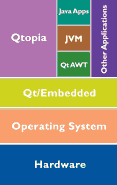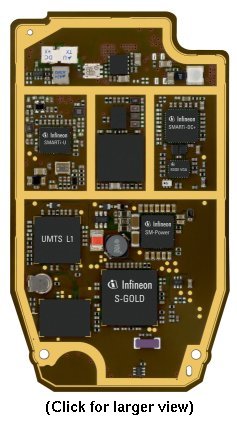3G Linux smartphone design debuts at 3GSM conference
Feb 11, 2005 — by Rick Lehrbaum — from the LinuxDevices Archive — views Four companies have collaborated on a Linux-based 3G smartphone reference design that will be demonstrated next week at the 3GSM World Congress in Cannes, France. The production-ready platform showcases “advanced 3G” and multimedia services including UMTS/EDGE voice/video calls, video streaming, web-browsing, ultra-fast multimedia, 3D-audio, and 3D-gaming.
Four companies have collaborated on a Linux-based 3G smartphone reference design that will be demonstrated next week at the 3GSM World Congress in Cannes, France. The production-ready platform showcases “advanced 3G” and multimedia services including UMTS/EDGE voice/video calls, video streaming, web-browsing, ultra-fast multimedia, 3D-audio, and 3D-gaming.
Infineon Technologies, Samsung Electronics, Trolltech, and Emuzed, who collaborated on the design, say they plan to market the hardware/software reference design to handset manufacturers that want to gain a quick foothold in the emerging UMTS/EDGE smartphone market using a Linux-based design. Support for UMTS and EDGE cellular standards gives the platform immediate access to wide mobile network coverage, and provides high bandwidth multimedia capabilities, the companies say.
EDGE is a 2.75G Internet access technology with growing penetration in Europe and the Americas, and UMTS is a 3G Internet access technology currently available in Europe, Japan, and elsewhere.
The reference design includes a combination of hardware and software components and technologies, and essentially comprises a production-ready blueprint for 3G smartphones, according to Trolltech CEO Haavard Nord. However, most handset makers will want to modify aspects of it, such as adding their own look-and-feel and branding to the user interface, Nord says.
The hardware platform consists of a 3G smartphone reference board (pictured on the right) developed by Infineon Technologies. It features Samsung's S3C24A0 application processor and camera module, and Infineon's MP-U UMTS/EDGE modem platform. The reference board targets small form-factor phone designs, and is supplied along with a compact “slider case,” Infineon says.
Samsung's S3C24A0 is complex system-on-chip “application processor” that integrates a large number of functions required in advanced 3G mobile phones. It is based on an ARM926EJ-S RISC microprocessor and includes ARM's Jazelle Java-acceleration technology, and supports processor clock rates up to 200 MHz. To support the performance demands of 2.5G and 3G communication services, the S3C24A0 implements a dual-32-bit bus architecture and includes hardware accelerators for motion-video processing, serial communications, and MPEG4 video encoding/decoding.
The S3C24A0 also integrates:
- 16KB instruction and data caches
- Memory management unit
- SDRAM controller
- 4 DMA channels
- 4 timing controllers
- TFT LCD controller
- Camera interface
- Dual-UART
- USB device/host ports
- IrDA, IIS, I2C interfaces
- AC97 audio interface
- 32-bits general purpose I/O
- Modem chip interface
- NAND Flash bootloader
- SD/MMC card interface
- Memory Stick Interface
- Keypad interface
- A-to-D converter and touchscreen interface
- System management functions (power management, etc.)
The software
 The software platform is a pre-integrated solution consisting of Infineon's UMTS/EDGE dual-mode protocol stack, Samsung's optimized Linux kernel and drivers (“certified by MontaVista”), Trolltech's Qtopia graphical application platform for Linux-based mobile phones, and Emuzed's audio and video applications, according to the companies.
The software platform is a pre-integrated solution consisting of Infineon's UMTS/EDGE dual-mode protocol stack, Samsung's optimized Linux kernel and drivers (“certified by MontaVista”), Trolltech's Qtopia graphical application platform for Linux-based mobile phones, and Emuzed's audio and video applications, according to the companies.
The demonstration will feature “compelling new Java applications” running on a high-performance Java implementation from Sun, and will also include ARM and Superscape's Swerve 3D rendering engine, Opera's Web browser, and QSound Labs's 3D audio and ringtone solutions, the companies say.
Emuzed says that its HipMedia integrated multimedia application enables a rich end-user experience for recording, playback, and sharing home movies, photo albums and music in an intuitive easy-to-use manner.
On the goodness of Linux in mobile phones
A joint statement released by Samsung and Infineon said, “The Open Source Linux Operating System is rapidly becoming a leading software platform for smartphones. Providing a common platform with a huge developer community, Linux offers vendors far greater independence as well as control over branding and the user interface, thereby driving innovation. The platform makes it easy for manufacturers to take advantage of benefits that Linux brings in term of cost efficiencies, flexibility, and functionality.”
Trolltech CEO Haavard Nord added, “The Linux operating system gives manufacturers independence and control, and it's clearly becoming a standard platform for smartphone design. Trolltech's Qtopia software is the face of Linux on mobile phones, offering a sophisticated, customizable application environment and user interface. Trolltech is pleased to collaborate with this group of industry leaders to combine many powerful technologies into an integrated, cutting-edge solution for 3G smartphones.”
Infineon executive vice president and general manager of the company's communication business group, Professor Dr. Hermann Eul, added, “According to a ZelosGroup report, Linux will secure a significant share of the feature and smartphone segment market in the next design cycle, especially due to its openness and low costs advantages. This complete solution will allow customers to enter the world of Linux-based UMTS/EDGE smartphones in record time and benefit from Infineon's recognized experience and expertise in the area of dual-mode modem and system integration.”
Samsung Electronics Semiconductor Business, System LSI division vice president Christopher D. Chang added, “This platform illustrates Samsung Electronics' outstanding capabilities in the mobile application processor and imaging areas, [and] demonstrates Samsung Electronics' leadership in providing a Linux solution for its line of mobile application processors targeting the smartphone market.”
This article was originally published on LinuxDevices.com and has been donated to the open source community by QuinStreet Inc. Please visit LinuxToday.com for up-to-date news and articles about Linux and open source.
